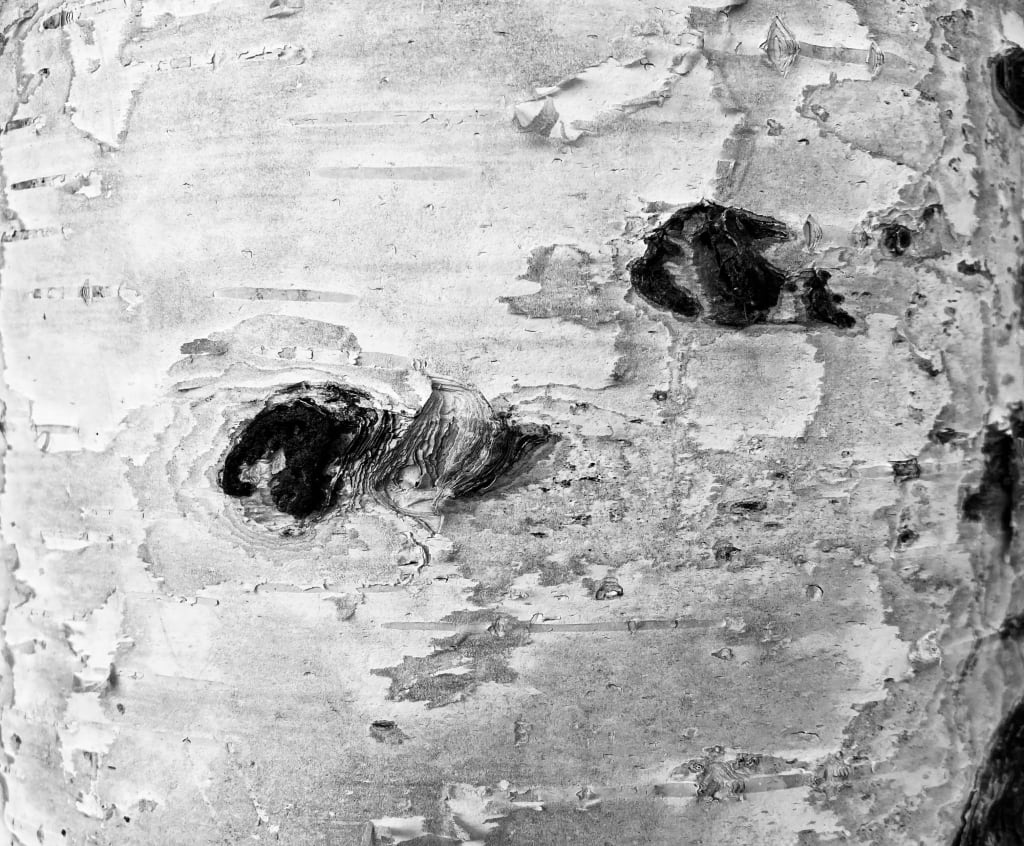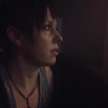
The cabin in the woods had been abandoned for years, but one night, a candle burned in the window. It used to be a frequent ritual of the mountain witch who lived there centuries before; she’d light a candle with every new tree she planted in her birch tree forest. But she was supposed to be gone. The candle was not supposed to light anymore. The lore surrounding the woods had festered and layered so much over the centuries that people generally stayed away from them now, more out of tradition than anything else.
The village folk will tell you that the forest—the birch tree forest—has eyes; they’ll tell you the trees scream in the night, and that it’s a forest with no shadows, because no light can reach between its branches.
A young woman named Roberta Jones, from out-of-town, had a different outlook: that’s how tall tales find their beginnings. Stories. Rumors. Myths. Folklore. Pick your flavor. But birch trees have natural markings that look like eyes, and wolves and wild cats live in these mountains. Have you ever heard a wild cat scream? The sound oscillates from other-worldly growls to something akin to a woman dying in agony. What the townspeople say…it’s just a lot of superstition.
Roberta was a journalist on an assignment to write an article on local folklore. She’d built her career around her skills of myth-debunking. Her editor would send her across the country and across the world—to the Himalayas to look into the Abominable Snowman, and to Scotland for the Loch Ness. One summer, she’d chased supposed Sasquatch sightings across Canada. Her stories were always compiled into her column, What the Townspeople Said, which was always a highlighted section in her magazine. She prided herself on her Nancy Drew-like reputation. Whisperings of the candle in the window lighting again had reached the ears of her editor, so Roberta had packed for the trip the very same day.
July 1, 2022: Notes
The townspeople always said it was bound to light again, eventually—the candle, that is. The way the village folk talked, you’d think it meant the End of Days or something. Witches are different everywhere—there are things to consider, like culture and time period. Historically, however, a common thread would be this: a woman with powers from the earth, generally used for dark purposes. How they obtain those powers, and their specific methodology varies from century to century, place to place. The witch of these woods, or, the Witch of the Woods, was of the Hansel-and-Gretel-type: she collected people. Young or old, male or female, it didn’t matter. She’d lure them with her candle in the window. A candle in a window would be a welcome sight to someone lost in a wood with neither light nor shadow. A wood with eyes and screaming trees.
She wouldn’t eat them, though. That seems to be another somewhat common thread in old witch lore. Cannibalism. Different woods, different witches, I guess. No; she’s supposedly a vegetarian, anyway (unless you count her birch tea, which some people do). Poison was her trickery. Poison, while cooing and smiling sweetly all the time. The village folk say she’s something of an herb goddess. She knows her way around a garden, she knows her way around a cup of tea.
Lost hikers, lost campers, would show up at her door, lured by the soft candlelight, and she’d have them in, give them tea and biscuits. The tea and biscuits, made with herbs from her own garden, and birch bark from the surrounding wood, would slowly paralyze and then asphyxiate the poor traveler. The Witch of the Woods would have a fresh corpse within the hour, which she would cremate and churn with dirt and seeds collected from her birch tree forest. She would then fill a mesh bag with the mixture and plant it in the woods, soon to grow into a thin, bony-white tree with dark eyes and dark, claw-like limbs. The ghosts of the lost travelers and campers were never to leave the forest, forever trapped in the roots and vessels of the trees, forever crying and howling their desperate warnings to any poor wanderer in the woods.
The Witch of the Woods has collected too many people to count, sources say, and if I tell you the story of one traveler, I’ve told them all. The story ends on a cold, winter’s night from a century or so ago when a witch from the north country bested her at her own trickery. The fabled “Witch of the Woods” was later buried as a birch tree in her own forest. The mysterious Witch of the North—or the Witch of the Woods, for that matter—was never heard from again—very conveniently, if you ask me.
Roberta shut her laptop and stood up from the small, motel-room desk. She threw a bottle of water, a granola bar, and a flashlight into her backpack, grabbed her handheld recorder, and headed out the door. She’d been collecting threads of the legend from the local folk for two weeks, and now came the fun part of recording her own eye-witness account. I have the best job, she thought as she headed toward the haunted wood.
Birch trees were Roberta’s favorite. They had the most delicate whispers, and in the autumn, it was as though the forest gnomes would spin the leaves into pure gold. She felt strange, though, as she entered the “haunted” wood. Goosebumps appeared on her arms with a surge of electricity. She shivered, then stifled a gasp as a wild goose ran frantically across the path in front of her. Feeling silly, she rolled her eyes and kept walking, but she pulled out her recorder and said, A classic goose-on-the-grave prank seems to have been played. Adds a certain charm to the spooky ambiance. She set the recorder to be operating as she walked, hoping to pick up the sounds of “screaming trees.”
The birch trees did seem to have distinct, haunted eyes. Dark, circular scars with curved, eyelid-looking lines stood out against their pale white trunks. Each tree had several eye-scars. A tortured soul sees with its whole self, Roberta said into her recorder, reflecting on the idea of having more than two eyes. These trees do have many “eyes,” which modern science tells us are where the tree has shed smaller branches not receiving enough sunlight.
Roberta continued to venture through the woods, which were hidden from the late-morning sunlight. Admittedly, the darkness is strange, she reported, but it is a thick wood. Nature has done stranger things. The sounds, though, were what truly pierced her to the very center. She had come prepared for the growls of bobcats and the howls of wolves; she was a hardened outdoorswoman. The sounds didn’t seem to be coming from the distance—they seemed to be fully surrounding her. Roberta’s hand shook as she brought the recorder close to her lips. I detest clichés—she was surprised to find that her voice was shaking too—and my editor will have my hide for this, but as I live and breathe, this screaming and howling has made my blood run cold. Forcing herself to swallow, she thought about turning back, but realized she was probably about halfway through the forest at this point, so she might as well press forward.
It seemed forever before she finally neared the edge of the wood, and by then, the screams and howls had grown almost deafening. It’s just the wind, she whispered, more to herself than her recorder, the wind and the wolves and the wildcats. She covered her ears with her hands, but the sounds still echoed inside her head. Dark branches from ghastly white trunks scratched and clawed at her, drawing blood in stripes across her own goose-bumped limbs. One last branch snagged her ponytail, and Roberta cried out in pain as she yanked herself free, stumbling into a small clearing.
Roberta’s entire body froze in place, except her eyes, which slowly, almost unwillingly, spanned her periphery. The howls had stopped, but somehow the silence made her stomach churn. There were no screams, no whispers, not even a cricket song. Fear pulsed through every vessel in her body, hypnotizing her. The woods around her blurred, and there was only one thing she could see, one thing she could think: the soft, tiny glow of the candle in the window. Its flickering deepened her trance as she made her way towards the rusted, rotted, run-down cabin.
The metal roof was shredded in several places, and all but one window was boarded up. A rusty, weather-worn sign hung from the door that read, simply: CONDEMNED.
Strangely tranquil now, Roberta’s feet brought her to the door, where she knocked three times.
The creature that opened the door looked only partly human. The age lines on her face more closely resembled the contour lines of bark on a tree. Her eyes were large and dark and lopsided, more dead than alive. They were, Roberta realized, the eyes of a birch tree. Where the creature’s hair should have been, there were tree branches sticking out in odd directions, with an occasional dead leaf still clinging for dear life. Her thin, faded blue dress and apron were torn and caked in dirt; worms and other crawlers creeped in and out of the dirt clumps, as though they and the witch were one entity. The Witch of the Woods, it seemed, had returned.
Most of these story pieces we have are added fragments from the townspeople, likely embellished over time, because Roberta Jones was never seen or heard from again. Her recorder was found, however, which helped to fill in a few details. In her honor, I would like to have the official record say that she merely lost her way in the woods—a tragic, but common accident. The Witch of the Woods and the story of her haunted birch trees was a lot of superstition circulated by the townspeople.
Off the record, however, I will say this: the tail-end of static noises found in her last recording give just a whisper of credence to those townspeople. The words are reported to sound distant, as if only background noise. The staticky voice is cracked and dry and eerily sweet. An odd and uneasy mix between a ghoul and a grandmother saying:
Well hello, dear. Won’t you come in for some tea?
About the Creator
CJ
Please, just let me midlife crisis in peace.
Enjoyed the story? Support the Creator.
Subscribe for free to receive all their stories in your feed. You could also pledge your support or give them a one-off tip, letting them know you appreciate their work.






Comments
There are no comments for this story
Be the first to respond and start the conversation.